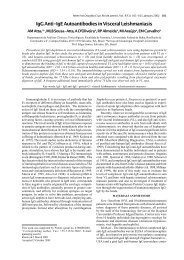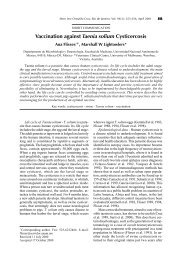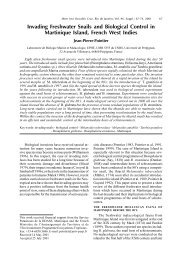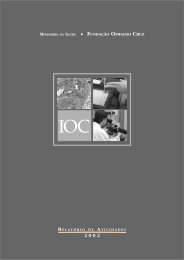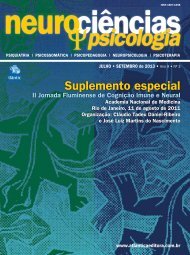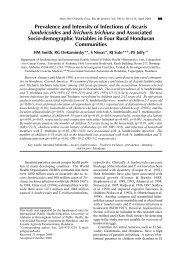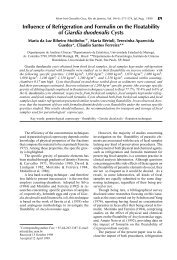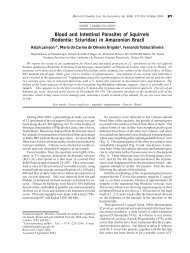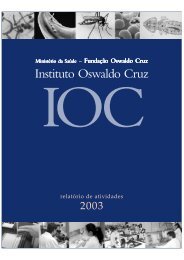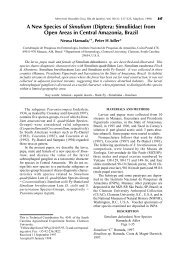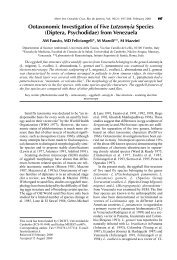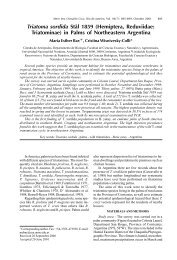The Schistosome Vectors in the Americas - SciELO
The Schistosome Vectors in the Americas - SciELO
The Schistosome Vectors in the Americas - SciELO
You also want an ePaper? Increase the reach of your titles
YUMPU automatically turns print PDFs into web optimized ePapers that Google loves.
Mem Inst Oswaldo Cruz, Rio de Janeiro, Vol. 96, Suppl., 2001<br />
9<br />
Fig. 2: present distribution of Biomphalaria glabrata and B. stram<strong>in</strong>ea <strong>in</strong> <strong>the</strong> Caribbean.<br />
from nor<strong>the</strong>astern states <strong>in</strong> <strong>the</strong> Naval School of Rio<br />
and to “P. olivaceus” from <strong>the</strong> state of Sergipe. In<br />
<strong>the</strong> last-mentioned paper he describes his procedure<br />
for concentration of schistosome eggs, now<br />
often referred to as <strong>the</strong> Hoffman-Pons-Janer’s (1934)<br />
method, proposed 18 years later.<br />
It can not be assured that Lutz was right <strong>in</strong> affirm<strong>in</strong>g<br />
that <strong>the</strong>re was no schistosomiasis from Rio<br />
de Janeiro southwards. Probably <strong>the</strong>re was no diagnosis.<br />
Nowadays it is known that <strong>the</strong>re is B.<br />
glabrata transmitt<strong>in</strong>g S. mansoni <strong>in</strong> sou<strong>the</strong>rn São<br />
Paulo and nor<strong>the</strong>rn Paraná. In Lutz’s collection<br />
<strong>the</strong>re are four specimens labeled P. confusus (but<br />
certa<strong>in</strong>ly B. glabrata) collected on May 5th, 1919<br />
<strong>in</strong> Jatahy (now Jataiz<strong>in</strong>ho, a town <strong>in</strong> nor<strong>the</strong>rn<br />
Paraná) by Souza-Araujo (1919), dur<strong>in</strong>g an extensive<br />
helm<strong>in</strong>thologic survey, from Sept. 1918 to Aug.<br />
1919, which did not reveal any case of schistosomiasis.<br />
It seems certa<strong>in</strong> that spread of <strong>the</strong> disease<br />
to nor<strong>the</strong>rn Paraná is relatively recent. Up to <strong>the</strong><br />
end of last century that region was covered by primary<br />
forest, a condition unfavorable for colonization<br />
by Biomphalaria. About 1867 it began to be<br />
settled by emigrants from São Paulo and M<strong>in</strong>as<br />
Gerais, occupation be<strong>in</strong>g completed <strong>in</strong> <strong>the</strong> 1920’s<br />
with high-scale coffee plantation. <strong>The</strong>re followed<br />
new immigratory waves, now from nor<strong>the</strong>astern<br />
states, <strong>the</strong> seat of <strong>the</strong> oldest foci of schistosomiasis.<br />
<strong>The</strong> association of three factors – devastation<br />
of <strong>the</strong> natural environment by <strong>in</strong>tensive agricultural<br />
exploitation, land occupation by immigrants<br />
of low socioeconomic status, and eutrophication<br />
of <strong>the</strong> bodies of water – would certa<strong>in</strong>ly stimulate<br />
proliferation of <strong>the</strong> preexistent molluscan vector.<br />
Fig. 3 shows <strong>the</strong> progression of B. glabrata <strong>in</strong> <strong>the</strong><br />
state of Paraná toward <strong>the</strong> Paraguayan frontier;<br />
records of successive surveys show that schistosomiasis<br />
did not preexist <strong>in</strong> <strong>the</strong> spotted localities.<br />
In Jan. 1997 a population of B. glabrata was<br />
found <strong>in</strong> Esteio, a locality of Rio Grande do Sul near<br />
Porto Alegre (Carvalho et al. 1998).<br />
Biomphalaria tenagophila<br />
This species was described by Orbigny (1835)<br />
as P. tenagophilus, based on specimens from <strong>the</strong><br />
Argent<strong>in</strong>e prov<strong>in</strong>ce of Corrientes. He found it aga<strong>in</strong><br />
<strong>in</strong> Rio de Janeiro, call<strong>in</strong>g it P. ferrug<strong>in</strong>eus Spix, which<br />
as seen above is a synonym of B. glabrata. He<br />
stated fur<strong>the</strong>r (Orbigny 1841) that he had collected<br />
it from marshes at São Cristóvão district, Rio de<br />
Janeiro city, “where it is very rare”. I searched for<br />
this planorbid <strong>in</strong> São Cristóvão, f<strong>in</strong>d<strong>in</strong>g specimens<br />
that agree with Orbigny’s description, but are <strong>in</strong>dist<strong>in</strong>guishable<br />
from B. tenagophila <strong>in</strong> anatomy<br />
and cross<strong>in</strong>g tests (Paraense 1961b).<br />
In 1856 Dunker described <strong>the</strong> species P.<br />
bahiensis, based on specimens collected <strong>in</strong> Bahia<br />
and Rio de Janeiro. As shown elsewhere (Paraense<br />
1961a, b), Dunker was really deal<strong>in</strong>g with two species:<br />
B. glabrata from Bahia and B. tenagophila<br />
from Rio de Janeiro.




